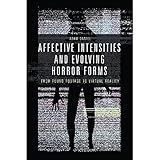Affective Intensities and Evolving Horror Forms : From Found Footage to Virtual Reality / Adam Daniel.
Material type: TextPublisher: Edinburgh : Edinburgh University Press, [2022]Copyright date: ©2020Description: 1 online resource (232 p.) : 25 B/W illustrationsContent type:
TextPublisher: Edinburgh : Edinburgh University Press, [2022]Copyright date: ©2020Description: 1 online resource (232 p.) : 25 B/W illustrationsContent type: - 9781474456357
- 9781474456371
- 791.43/6164 23
- PN1995.9.H6 D35 2020
- online - DeGruyter
| Item type | Current library | Call number | URL | Status | Notes | Barcode | |
|---|---|---|---|---|---|---|---|
 eBook
eBook
|
Biblioteca "Angelicum" Pont. Univ. S.Tommaso d'Aquino Nuvola online | online - DeGruyter (Browse shelf(Opens below)) | Online access | Not for loan (Accesso limitato) | Accesso per gli utenti autorizzati / Access for authorized users | (dgr)9781474456371 |
Browsing Biblioteca "Angelicum" Pont. Univ. S.Tommaso d'Aquino shelves, Shelving location: Nuvola online Close shelf browser (Hides shelf browser)

|

|

|

|

|

|

|
||
| online - DeGruyter Contemporary Perspectives on Revelation and Qu’ranic Hermeneutics : An Analysis of Four Discourses / | online - DeGruyter Cinema and Soft Power : Configuring the National and Transnational in Geo-politics / | online - DeGruyter Visions of Council Democracy : Castoriadis, Lefort, Arendt / | online - DeGruyter Affective Intensities and Evolving Horror Forms : From Found Footage to Virtual Reality / | online - DeGruyter ReFocus : The Films of Sohrab Shahid Saless: Exile, Displacement and the Stateless Moving Image / | online - DeGruyter Lyotard and Politics : A Critical Introduction / | online - DeGruyter Literature and Consolation : Fictions of Comfort / |
Frontmatter -- Contents -- List of Figures -- Acknowledgements -- Introduction -- 1. Fro m the Semantic to the Somatic: Aff ective Engagement with Horror Cinema -- 2. From Identifi cation to Embodied Spectatorship in the Found Footage Horror Film -- 3. Camera Supernaturalis -- 4. Perception and Point of View in the Found Footage Horror Film: New Understandings via Deleuze’s Perception-Image -- 5. Horrific Entwinement: Affective Neuroscience and the Body of the Horror Spectator -- 6. What Hides behind the Stream: Post-Cinematic Hauntings of the Digital -- 7. Th e Evolving Screen Forms of New Media Horror -- 8. Th e Embodied Player of Horror Video Games -- 9. Th e Spectator-Interactor of Virtual Reality Horror -- Conclusion -- Bibliography -- Index
restricted access online access with authorization star
http://purl.org/coar/access_right/c_16ec
Explores theories of cinematic embodiment and affect in relation to horror filmExamines cutting-edge new media forms of horror through distinct and progressive theoretical lensesIntegrates theoretical insights from neuroscience into the study of horror mediaOutlines the burgeoning new field of virtual reality cinema, and argues for innovative theoretical approaches to this new modalityConsiders textual works that have had limited scholarly analysis, such as Youtube horror media series and recent found footage films (e.g. the Creep films and #Screamers)Horror cinema is a genre that is undergoing constant evolution, from the sub-genre of ‘found footage,’ to post-cinematic new media forms such as Youtube horror, horror video games and cinematic virtual reality horror. By investigating how these new forms alter the dynamics of spectatorship, this book charts how cinema’s affective capacities have shifted in relation to these modifications in the forms of cinematic horror. It applies a rich theoretical synthesis of phenomenological and Deleuzian approaches to a number of case studies, including films like The Blair Witch Project, Paranormal Activity and Creep as well as video games such as Alien: Isolation and new media forms such as Youtube horror and virtual reality horror.
Mode of access: Internet via World Wide Web.
In English.
Description based on online resource; title from PDF title page (publisher's Web site, viewed 27. Jan 2023)


